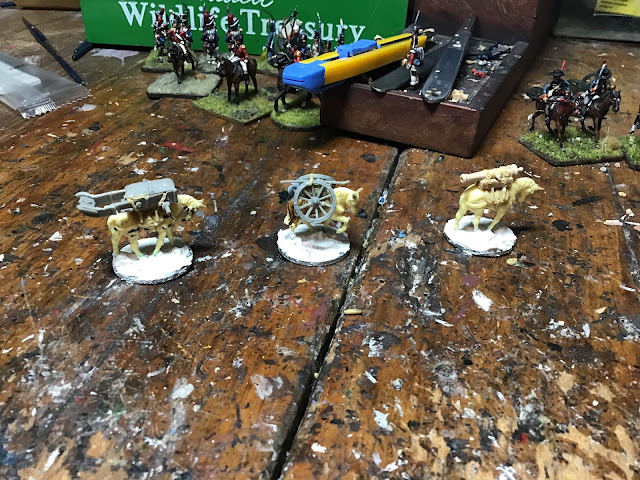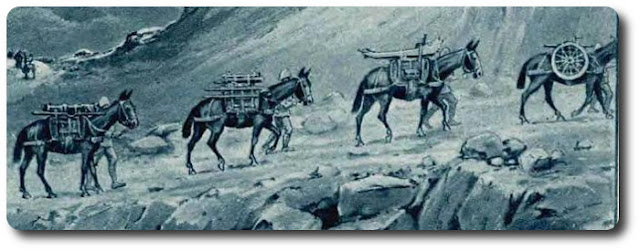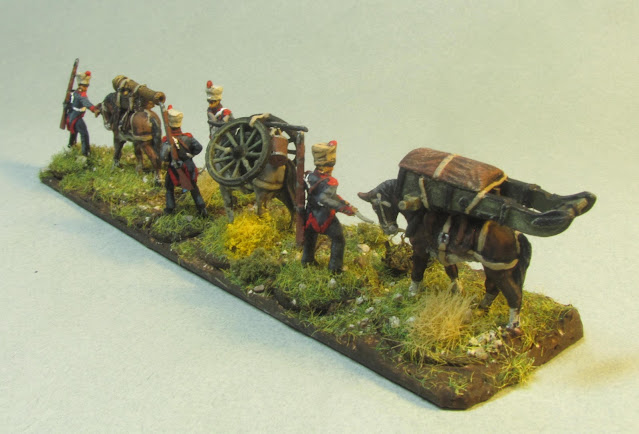I was inspired to try and build a French mountain gun, disassembled and carried on mules, as I have some Pyrennes games that may call for one of these batteries. Visual reference was slim on the net, but I did find a couple of later era mountain guns on mules that gave me a starting point at least.
A bit of history
The Grande Armée mountain artillery units were not permanently organized, but rather were handled by regular foot artillery. There were two basic types of mountain guns employed, a French system on a "chevrette" carriage (not quite clear on this, but I think a carriage without wheels) and a Piedmontese wheeled carriage. Both were broken down and carried on mules, as was the portable forge, ammunition and other items required of the battery. The Piedmontese wheeled gun, although not built by the French, proved to be the more popular because the piece was higher and less likely to overset when fired. Eighteen mules were needed to carry a two gun 3-pounder section.
Mountain artillery was employed with good results in Italy, the Tyrol and in Spain after unsuccessfully trying to move regular artillery over the Alps during the Marengo campaign.
For more information:
https://weaponsandwarfare.com/2018/07/09/french-artillery-napoleonic-wars-i/
The Build
Normally I am done a project before I think about posting, never mind recording, a WIP. I decided to make the unit modular so the mule models can be used separately as well, and possibly allowing other nationalites to be inserted as the figures. I confess, the gun itself, especially the carriage, is a bit of an invention based on a Gribeauval carriage, as I could find no good reference for mountain artillery that was broken down and carried such as these guns were, other than that posted above.

First step was to gather up these bits from my parts box. I used some old Airfix French Napoleonic artillery horses as they are a bit smaller and sturdy-looking, good for conversion to mules. Here I have already elongated the horses' ears and thickened their muzzles with putty.

This picture is just me glueing the bits onto the mules and attaching them to their washer bases. I used balsa wood for the boxes and have sculpted a rough carrying pad for the backs.

Next step was sculpting the belts, harness and ropes holding everything in place. I have three mules, one for the cannon, one for the carriage and one for the wheels. Ammunition would be on other mules but these will do for my model so it doesn't take up too much real estate on the gaming table. The blue tacky stuff is just to keep the horses supported while I do my sculpting.

Here they are with the basing applied.

Now the handlers. I converted some later war Hat French artillery to earlier war, as the poses worked. I probably could have kept them as later war (this is for 1813) but then they wouldn't really look matched to all of my French in the pre-Baudin uniform. I found the shakos small on this set so puttied them up larger with shako covers. Other conversions were the lengthening of the tails, attaching muskets, and modelling the open front jacket to show the vest. My sculpting is always pretty rough - these are gaming models and my skill limited!

I enjoyed the problem solving around this part. I glued a thin flexible magnet strip to the base and placed the figures where they would go.

Then I applied my basing material (a plastering compound) on the base up to the edges of the stands...

And finally I removed the figures while the compound was still wet and allowed the base to dry. I firmed up the edges of the holes with white glue, and now I am ready to paint. Because the figures are on metal washers with a magnet base, I can pop them on and off as needed.
And a few photos of the finished piece
 |
| Here is the unit attached to its magnetic base. I had hoped the assembly would be a bit more seamless, but it works! |
 |
| The wheels, bucket and tools were scrounged from various sets, with a bit of sculpting for the straps and harness. |
 |
| Again, the gun carriage was cut down in size considerably, to be more the dimensions of the one in my reference. The cover is just pure invention, an extra piece I had kicking around. |










Fantastic conversions and brushwork!
ReplyDeleteGreetings
Peter
Thank you, Peter. It was a lot of fun.
DeleteThat's a fabulous conversion and arrangement into a base; with flexibility too!
ReplyDeleteThe Airfix horses make wonderful mules. An inspired conversion.
Regards, James
Thanks, James. Yes, it's hard to find horses not in some sort of gallop and these old Airfix figures especially had just the right build.
Delete